
Diplacus aurantiacus, the sticky monkey-flower or orange bush monkey-flower, is a flowering plant that grows in a subshrub form, native to southwestern North America from southwestern Oregon south through most of California. It is a member of the lopseed family, Phrymaceae. It was formerly known as Mimulus aurantiacus.

Holodiscus discolor, commonly known as ocean spray or oceanspray, creambush, or ironwood, is a shrub of western North America.

Phacelia crenulata is a species of flowering plant in the borage family, Boraginaceae. Its common names include notch-leaf scorpion-weed, notch-leaved phacelia, cleftleaf wildheliotrope, and heliotrope phacelia. Phacelia crenulata has an antitropical distribution, a type of disjunct distribution where a species exists at comparable latitudes on opposite sides of the equator, but not at the tropics. In North America, it is native to the southwestern United States as far east as Colorado and New Mexico, and Baja California and Sonora in Mexico. In South America, it is native to southern Peru, western Bolivia, and northern Chile.

Phacelia fremontii is a flowering plant in the family Boraginaceae native to the southwestern United States. In California, its range includes the Mojave Desert, the San Joaquin Valley, the Coast Ranges, and the Sierra Nevada. It was named for John C. Frémont.
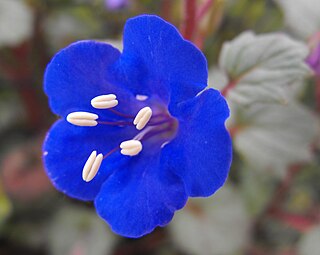
Phacelia campanularia is a species of flowering plant in the borage family, Boraginaceae, known by the common names desertbells, desert bluebells, California-bluebell, desert scorpionweed, and desert Canterbury bells. Its true native range is within the borders of California, in the Mojave and Sonoran Deserts, but it is commonly cultivated as an ornamental plant and it can be found growing elsewhere as an introduced species.
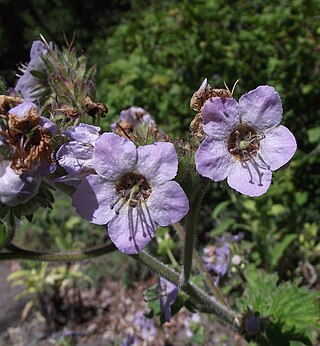
Phacelia bolanderi is a species of flowering plant known by several common names, including Bolander's phacelia, Bolander's scorpionweed, blue-flowered grape-leaf, and caterpillar flower. The plant is native to Oregon and coastal northern California. It was named for the California botanist Henry Nicholas Bolander.
Phacelia affinis is a species of flowering plant in the borage family, Boraginaceae, known by the common names limestone phacelia and purple-bell scorpionweed. It is native to the southwestern United States and Baja California and Sonora in Mexico. It can be found in scrub, woodland, forest, and other habitat.
Phacelia austromontana is a species of phacelia known by the common name Southern Sierra phacelia. It is native to the southwestern United States, where it can be found in the Transverse Ranges and Sierra Nevada of California east to Utah. It grows in open mountainous habitat.
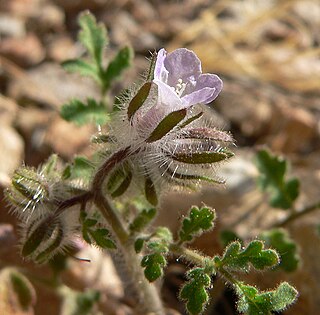
Phacelia cryptantha is a species of flowering plant in the borage family, Boraginaceae, known by the common name hiddenflower phacelia. It is native to the southwestern United States and Baja California in Mexico, where it grows in several habitat types in desert, rocky mountain slopes, canyons, plateau, and other areas.

Phacelia curvipes is a species of flowering plant in the borage family, Boraginaceae, known by the common names Washoe phacelia and Washoe scorpionweed. It is native to the southwestern United States, where it grows in many types of habitat, such as chaparral, oak and pine woodland, and forests.
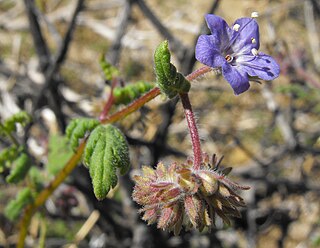
Phacelia distans is a species of flowering plant in the borage family, Boraginaceae, known by the common names distant phacelia and distant scorpionweed. It is native to the southwestern United States and northwestern Mexico, where it grows in many types of habitat, including forest, woodland, chaparral, grassland, and meadows.

Phacelia hastata is a species of flowering plant in the borage family, Boraginaceae. Its common names include silverleaf scorpionweed, silverleaf phacelia, and white-leaf phacelia. It is native to western North America from British Columbia and Alberta south to California and east to Nebraska. It can be found in many types of habitat, including scrub, woodland, and forest, up to an elevation of 13,000 feet. It prefers sandy to rocky soil.

Phacelia humilis, with the common name low phacelia, is a species of phacelia. It is native to the Western United States, from central Washington to central California, where it grows in mountain and foothill habitat.

Phacelia ivesiana is a species of flowering plant in the borage family, Boraginaceae. Its common names include Ives' phacelia and Ives' scorpionweed. It is divided into varieties that have been called sticky scorpionweed. It is native to the western United States.

Phacelia neglecta is a species of flowering plant in the borage family, Boraginaceae. Its common names include alkali phacelia and neglected scorpionweed. It is native to the deserts of the southwestern United States in Nevada, Arizona, and southeastern California, where it grows in varied desert habitat, including areas with alkali soils. It is likely that its distribution extends into Baja California.
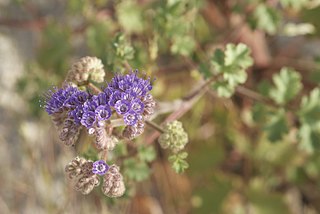
Phacelia pedicellata is a species of flowering plant in the borage family, Boraginaceae. Its common names include specter phacelia and pedicellate phacelia. It is native to the southwestern United States and Baja California, where it can be found in several types of habitat, including creosote bush scrub and Joshua tree woodland.

Phacelia rotundifolia is a species of flowering plant in the borage family, Boraginaceae, known by the common name roundleaf phacelia. It is native to the southwestern United States, where it can be found in habitat types such as creosote bush scrub and pinyon-juniper woodland.

Phacelia stellaris is a rare species of flowering plant in the borage family, Boraginaceae, known by the common names star phacelia and Brand's phacelia.

Phacelia tanacetifolia is a species of flowering plant in the borage family Boraginaceae, known by the common names lacy phacelia, blue tansy, purple tansy or fiddleneck (UK).

Phacelia vallis-mortae is a species of flowering plant in the borage family, Boraginaceae, known by the common name Death Valley phacelia. It is native to the southwestern United States, where it grows in deserts such as Death Valley, and mountain, plateau, and valley scrub habitat.



















